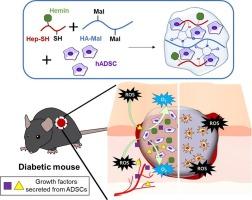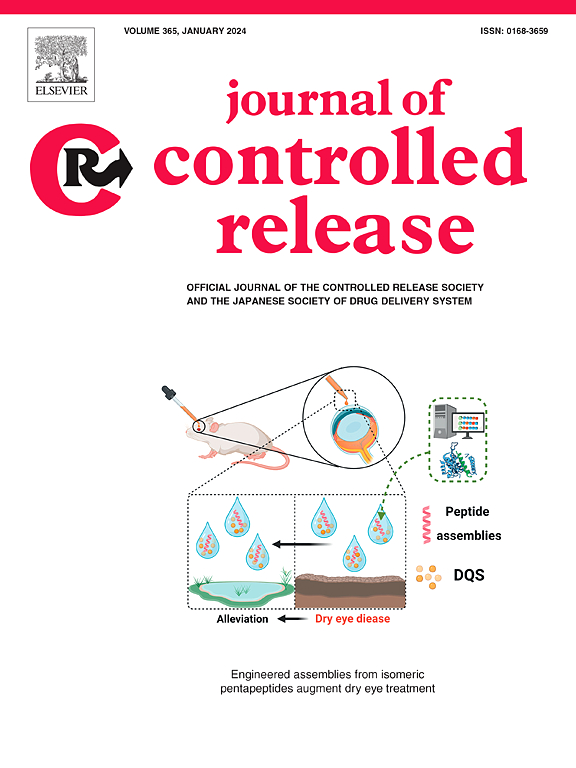Enhanced secretion of growth factors from ADSCs using an enzymatic antioxidant hydrogel in inflammatory environments and its therapeutic effect
IF 10.5
1区 医学
Q1 CHEMISTRY, MULTIDISCIPLINARY
引用次数: 0
Abstract
A catalytic ROS-scavenging hydrogel (HGel) was developed to enhance the growth factor secretion and the therapeutic efficacy of human adipose-derived stem cells (hADSCs) in inflammatory environments. The HGel is composed of heparin and hyaluronic acid, further functionalized with hemin to endow superoxide dismutase and catalase activities. The functionalization of hemin enables the HGel to effectively scavenge ROS (superoxide and H2O2), thereby protecting encapsulated hADSCs from oxidative stress and maintaining their metabolic activities. As a result, the HGel enhanced growth factor secretion of hADSCs in inflammatory conditions compared to non-functionalized, bare heparin/hyaluronic acid hydrogel (Gel). The therapeutic efficacy of the hADSC-encapsulated HGel (C/HGel) was evaluated in a diabetic wound model. The C/HGel significantly accelerated wound closure, reduced ROS levels, mitigated inflammation, and promoted angiogenesis compared to the hADSC-encapsulated Gel (C/Gel) as well as the HGel itself. The HGel has the potential to be utilized as an excellent cell carrier for stem cell therapy in various inflammatory diseases. Overall, this study demonstrated a strategy of enhancing growth factor secretion from stem cells using catalytic antioxidant hydrogels for superior regenerative effects in cell therapy.

在炎症环境中使用酶抗氧化水凝胶增强 ADSCs 的生长因子分泌及其治疗效果。
为了提高人脂肪来源干细胞(hADSCs)在炎症环境中的生长因子分泌和治疗效果,我们开发了一种催化ROS清除水凝胶(HGel)。HGel 由肝素和透明质酸组成,并进一步用海明进行功能化,以赋予超氧化物歧化酶和过氧化氢酶活性。海明的功能化使 HGel 能够有效清除 ROS(超氧化物和 H2O2),从而保护封装的 hADSC 免受氧化应激,并保持其代谢活性。因此,与无功能化的裸肝素/透明质酸水凝胶(Gel)相比,HGel 能增强 hADSCs 在炎症条件下的生长因子分泌。在糖尿病伤口模型中对包封了 hADSC 的水凝胶(C/HGel)的治疗效果进行了评估。与 HADSC 包裹凝胶(C/Gel)和 HGel 本身相比,C/HGel 能明显加快伤口闭合、降低 ROS 水平、减轻炎症反应并促进血管生成。HGel有望成为干细胞治疗各种炎症性疾病的绝佳细胞载体。总之,这项研究展示了一种利用催化抗氧化水凝胶增强干细胞分泌生长因子的策略,从而在细胞治疗中实现卓越的再生效果。
本文章由计算机程序翻译,如有差异,请以英文原文为准。
求助全文
约1分钟内获得全文
求助全文
来源期刊

Journal of Controlled Release
医学-化学综合
CiteScore
18.50
自引率
5.60%
发文量
700
审稿时长
39 days
期刊介绍:
The Journal of Controlled Release (JCR) proudly serves as the Official Journal of the Controlled Release Society and the Japan Society of Drug Delivery System.
Dedicated to the broad field of delivery science and technology, JCR publishes high-quality research articles covering drug delivery systems and all facets of formulations. This includes the physicochemical and biological properties of drugs, design and characterization of dosage forms, release mechanisms, in vivo testing, and formulation research and development across pharmaceutical, diagnostic, agricultural, environmental, cosmetic, and food industries.
Priority is given to manuscripts that contribute to the fundamental understanding of principles or demonstrate the advantages of novel technologies in terms of safety and efficacy over current clinical standards. JCR strives to be a leading platform for advancements in delivery science and technology.
 求助内容:
求助内容: 应助结果提醒方式:
应助结果提醒方式:


